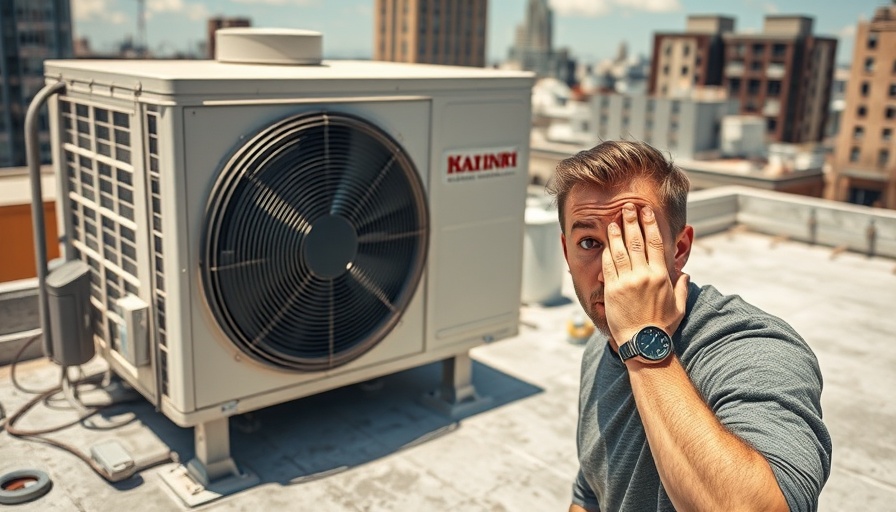
Revolutionizing Your RV Experience with Turbo Inverter Units
For RV enthusiasts, staying comfortable during hot summer months can sometimes be a challenge, especially with older technology. Upgrading your air conditioning system can not only boost comfort but also enhance energy efficiency and save you money. This does not just apply to living spaces in houses; RVs are prime candidates for technology upgrades to improve their livability. A recent video showcases how replacing an outdated air conditioning unit with a modern turbo inverter heat pump system can transform your traveling experience.
In the video 'RV Mini Splits Just Entered The Chat...', the discussion dives into modern RV air conditioning technology, prompting us to explore the broader implications of these innovations.
What is a Turbo Inverter Heat Pump?
The newly installed turbo inverter heat pump is a game-changer. It utilizes inverter technology to drastically reduce energy consumption. Unlike traditional units, which can pull high amounts of energy at startup, the new system ramps up according to the cooling needs, thereby consuming less overall electricity—roughly half the energy of older models. This means that even with access to a small generator, your RV can remain cool and comfortable amidst the sweltering heat of Houston.
Installation: A Step-by-Step Guide
Replacing your old AC unit isn't just an upgrade; it's an empowering DIY project. Here are the steps involved in the installation:
- Remove the old AC unit carefully, disconnecting electrical connections and unscrewing it from the roof.
- Position the new turbo inverter unit using a ladder crane for added safety and convenience.
- Seal any gaps, ensuring a perfect fit and eliminating air leaks.
- Connect the wiring according to the manufacturer's instructions, ensuring all connections are secure.
- Test the unit by powering it on, verifying that the airflow is strong and the compressor operates quietly.
The entire process can be performed with common tools, making it accessible even for amateur DIYers.
Why Consider This Upgrade?
The benefits of upgrading to a turbo inverter system extend beyond energy efficiency. First, it turns your RV into a dual-fuel heating system, capable of utilizing both electricity and gas for heating. Second, its quieter operation makes for a more pleasant camping experience. Lastly, it provides peace of mind: no longer will you worry about inadequate cooling in your RV during the scorching summers typical of Houston.
Future Insights and Trends in HVAC Technology
The trend toward inverter technology is likely to continue expanding into various aspects of HVAC systems for residential areas. Innovations aimed at energy conservation will not only lower utility bills but also reduce our carbon footprint. Homeowners in Houston should stay informed on advancements, especially considering this area's unique climate challenges.
Expertise in HVAC Services in Houston
If you are considering upgrading your air conditioning system but are unsure where to start, Houston is home to various reliable HVAC contractors who can assist with both installation and maintenance. Investing in a professional service will ensure your unit operates optimally and lasts longer, saving you from costly repairs. Some of the best AC companies in Houston offer tailored solutions to meet your specific needs, including emergency HVAC repairs, routine maintenance options, and consultations on energy efficiency improvements.
Regardless of whether you decide to upgrade your RV or your home systems, understanding your options allows you to make informed decisions.
When it comes to maintaining your air conditioning system, quality HVAC services are crucial. Typically, you should schedule maintenance at least once or twice a year, especially before peak seasons. This ensures your unit is working efficiently and can extend the lifespan of your system.
Take Advantage of HVAC Innovations
With the rise of inverter technology and energy-efficient systems, upgrading to a more modern HVAC unit significantly enhances both comfort and sustainability. Make sure to explore affordable HVAC services in Houston that can meet your needs without breaking the bank. And remember, learning about these systems can empower you as a homeowner or as someone who enjoys life on the road in an RV.
Your Next Steps
If you're ready to enhance your RV experience or want to boost your home's comfort, consider reaching out to professional HVAC experts for guidance. They'll provide insight into the best units for your energy needs and help with installation. Don't let aging technology hold you back from ultimate comfort—upgrading your system is an excellent investment in your quality of life.
 Add Row
Add Row  Add
Add 




Write A Comment